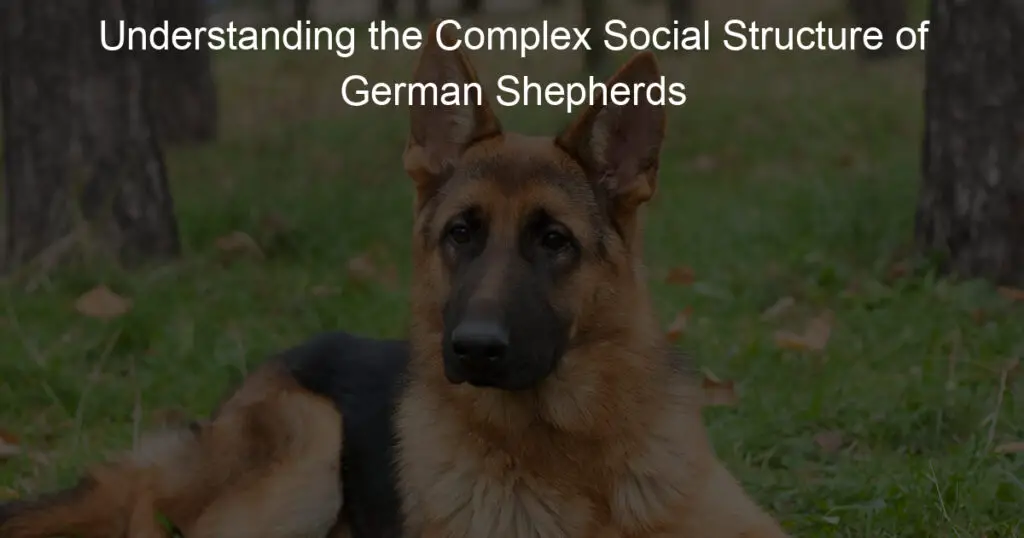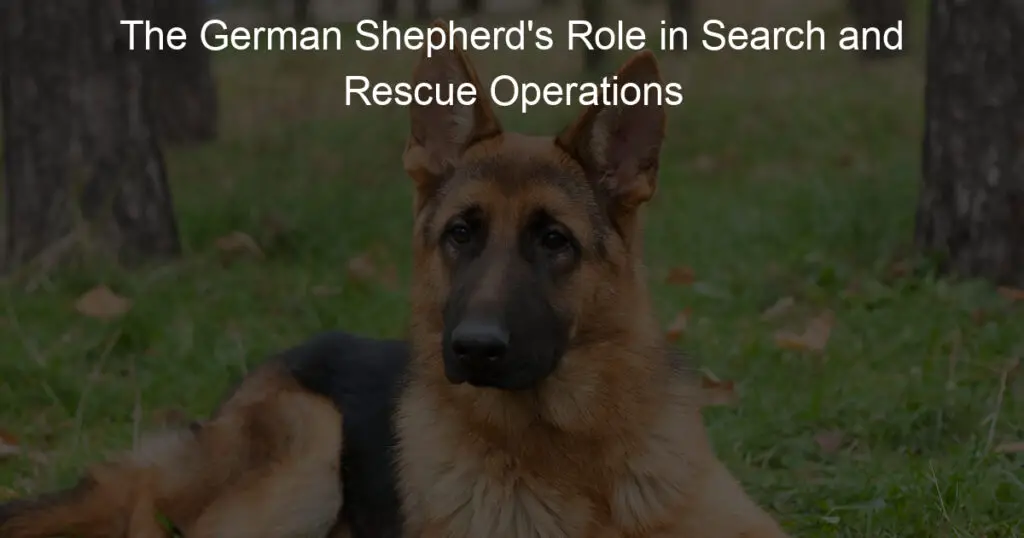German Shepherds are one of the most recognizable and popular dog breeds in the world, renowned for their intelligence and versatility. However, these dogs have a complex social structure that plays a pivotal role in their behavior and relationships. This article delves into the intricate social hierarchy of German Shepherds, exploring their behavior, communication, and the influence of pack mentality.
1. The Importance of Social Structure in Canines
Social structure plays a crucial role in the lives of canines, including German Shepherds. Dogs are pack animals by nature, and their social structure helps to establish order, hierarchy, and cohesion within the group. It provides them with a sense of security, belonging, and purpose. Just like wolves, from whom they descend, German Shepherds have a deeply ingrained instinct to live within a social structure.
Within the social structure, each member has a specific role and position. This structure helps to prevent conflicts and ensures the smooth functioning of the group. It also facilitates communication and cooperation, allowing dogs to work together effectively. Understanding the complex social structure of German Shepherds is essential for owners to provide them with a fulfilling and balanced life.
In a canine social structure, there is a clear hierarchy with a dominant leader at the top. This leader, often referred to as the alpha, is responsible for making decisions and maintaining order. Other members of the pack follow the leader's guidance and respect their authority. Establishing yourself as the leader in your German Shepherd's social structure is important for effective training and behavior management.
Furthermore, the social structure of German Shepherds extends beyond their interactions with other dogs. They also form strong bonds with their human family members, considering them as part of their pack. This bond and the understanding of their position within the family hierarchy contribute to their overall well-being and behavior.
Neglecting or disrupting the social structure of a German Shepherd can lead to behavioral problems such as aggression, anxiety, or excessive dominance. It is important to provide them with consistent leadership, clear boundaries, and opportunities for socialization to maintain a healthy social structure.
2. 'Are German Shepherds Pack Dogs?'
German Shepherds are indeed pack dogs, and their social nature is deeply rooted in their ancestry. Understanding their pack mentality can provide valuable insights into their behavior and needs.
- 1. Pack Instincts:
German Shepherds have a strong instinctual drive to live within a pack. This instinct comes from their ancestors, the wolves, who are known for their highly organized social structures. German Shepherds have inherited this pack mentality, which influences their behavior and interactions with other dogs and humans. - 2. Hierarchy and Order:
Within a pack, there is a clear hierarchy with a dominant leader at the top. German Shepherds naturally seek a leader to follow and look for guidance. As pack animals, they thrive in an environment where they have a clear understanding of their position within the hierarchy. It is essential for owners to establish themselves as the pack leader to provide a sense of security and stability for their German Shepherd. - 3. Pack Mentality and Bonding:
German Shepherds form strong bonds within their pack, whether it is with other dogs or their human family. They rely on these bonds for companionship, protection, and social interaction. Being pack-oriented animals, they can develop separation anxiety or exhibit destructive behaviors when left alone for extended periods. Providing them with ample socialization, companionship, and engagement helps fulfill their pack mentality needs.
3. Communication and Body Language
Communication plays a vital role in the complex social structure of German Shepherds. They have a rich repertoire of body language and vocalizations that they use to convey their intentions, emotions, and establish social boundaries.
German Shepherds use a combination of facial expressions, body postures, and vocalizations to communicate with other dogs and humans. They have a keen ability to read and interpret body language, allowing them to gauge the intentions and emotions of those around them.
Certain behaviors, such as wagging tails, raised hackles, and erect ears, can indicate various states of mind. A wagging tail, for example, can signal friendliness and excitement, while a stiff, raised tail can indicate alertness or aggression. Similarly, raised hackles signify arousal or potential aggression, and erect ears demonstrate attentiveness.
Eye contact is another essential aspect of communication for German Shepherds. Direct eye contact is seen as a challenge or a threat, while avoiding eye contact can be a sign of submission or fear. Understanding these subtle cues can help owners effectively communicate with their German Shepherds and interpret their responses.
Vocalizations also play a role in communication. German Shepherds have a wide range of vocalizations, including barking, growling, whining, and howling. Each vocalization serves a specific purpose, such as alerting to danger, expressing discomfort, or seeking attention.
4. The Leader-Follower Relationship
The leader-follower relationship is a fundamental aspect of the social structure of German Shepherds. As descendants of wolves, German Shepherds have inherited a hierarchical system where there is a clear leader and followers within a group. In a household setting, the owner is expected to assume the role of the leader, providing guidance, structure, and protection to their German Shepherd.
Establishing oneself as the leader requires consistent and fair leadership. German Shepherds are instinctively inclined to follow a strong and confident leader who can make decisions and set boundaries. This means that owners need to establish clear rules and expectations for their German Shepherds and consistently enforce them.
Leadership is not about dominance or physical force but rather about earning respect and trust. Positive reinforcement techniques, such as rewards and praise, can be used to reinforce desired behaviors and build a strong bond between the owner and their German Shepherd.
In the leader-follower relationship, it is important for the owner to be proactive and take initiative in providing guidance and direction. This includes training sessions, daily routines, and structured activities that engage the German Shepherd's mind and body.
By assuming the role of a leader, owners can help their German Shepherds feel secure and confident. This, in turn, helps prevent behavioral issues such as aggression or anxiety that can arise when a dog feels uncertain or lacks proper guidance. A strong leader-follower relationship lays the foundation for a well-behaved and balanced German Shepherd.
5. Role of Play in Social Structure
Play is a crucial component of the social structure of German Shepherds. It serves multiple purposes, including bonding, communication, and the establishment of social hierarchies within a group. Play allows German Shepherds to learn important social skills and develop relationships with other dogs and humans.
During play, German Shepherds engage in various behaviors such as chasing, wrestling, and mock fighting. These activities help them practice their physical coordination, develop their strength, and learn to control their bite inhibition. Play also allows them to learn how to interpret and respond to different body language signals, such as play bows and barks.
Play is not only essential for physical and social development but also for mental stimulation. Interactive play, such as puzzle toys or hide-and-seek games, challenges their problem-solving abilities and keeps their minds sharp. It provides an outlet for their natural instincts and helps prevent boredom and destructive behaviors.
In the social structure of German Shepherds, play also serves to establish and reinforce social hierarchies. Through play, they learn to recognize and respect the boundaries and preferences of others. It helps them understand their place within the group and teaches them important social skills, such as taking turns and sharing resources.
As responsible owners, it is important to provide opportunities for play in a safe and controlled environment. Regular play sessions with other dogs or supervised playdates can enhance the socialization skills of German Shepherds. Engaging in interactive play with their owners also strengthens the bond and trust between them.
6. 'How Does Training Influence the Social Structure?'
Training plays a significant role in shaping the social structure of German Shepherds. It establishes boundaries, reinforces desired behaviors, and helps develop a strong bond between the dog and their owner. Training provides structure and guidance, which is essential for German Shepherds to understand their place within the social hierarchy.
One way training influences the social structure is by establishing clear leadership. Through consistent and positive reinforcement training methods, owners can assert themselves as the pack leader. This helps German Shepherds understand who is in charge and promotes a harmonious relationship within the family.
Training also helps German Shepherds develop self-control and impulse management. By teaching them commands such as sit, stay, and leave it, owners can guide their dogs' behavior in various social situations. This not only fosters obedience but also teaches German Shepherds to respect boundaries and interact appropriately with others.
Furthermore, training provides mental stimulation and challenges for German Shepherds. Engaging in training exercises, such as obedience or agility training, helps keep their minds active and prevents boredom. This, in turn, contributes to their overall well-being and can positively impact their social interactions.
Additionally, training can help German Shepherds become more sociable and friendly towards other dogs and humans. Through proper socialization training, they learn to be comfortable and calm in various environments and around different individuals. This reduces the likelihood of fear or aggression-related issues and promotes positive social interactions.
7. Bonding and Affection: More Than Just a Pet
When it comes to German Shepherds, the bond between the dog and their owner goes beyond the typical pet-owner relationship. German Shepherds have a deep capacity for affection and form strong emotional connections with their human companions. This bond is built on mutual trust, love, and companionship, and it plays a crucial role in their social structure.
German Shepherds are known for their loyalty and protective nature, which stems from their innate desire to bond with their owners. They thrive on the love and attention they receive and are always eager to please. This deep connection allows German Shepherds to understand and respond to their owner's emotions, making them excellent companions and support animals.
In addition to their loyalty, German Shepherds also have a strong need for physical affection. They enjoy cuddling, being petted, and being close to their owners. These moments of physical contact not only provide comfort but also strengthen the bond between the dog and their owner. Regular displays of affection help German Shepherds feel secure and loved, further solidifying their place within the social structure of the family.
Furthermore, the bond between a German Shepherd and their owner has practical benefits as well. It facilitates effective communication and understanding, allowing owners to better interpret their dog's needs and desires. This understanding helps foster a harmonious relationship and ensures that the German Shepherd's social and emotional needs are met.
8. The Impact of Human Family on German Shepherds
German Shepherds are highly adaptable and versatile dogs, and their social structure extends beyond their relationship with their owners. The composition of the human family can significantly impact a German Shepherd's behavior and overall well-being.
- – New Line
The presence of children in the household can greatly influence the socialization of German Shepherds. They tend to be patient and gentle with children, making them excellent family dogs. However, it is crucial to supervise interactions between young children and German Shepherds to ensure both parties' safety and prevent any unintentional harm. - – New Line
The number of family members and their individual roles within the household can also affect the German Shepherd's social structure. If there are multiple adults in the family, the dog may form different bonds and exhibit different behaviors towards each person based on their individual interactions and levels of authority. Similarly, if there are other pets in the household, the German Shepherd's social dynamics may adjust to accommodate the presence of other animals. - – New Line
Consistency in training and discipline is essential for German Shepherds in a family setting. When everyone in the family follows the same rules and guidelines, it helps establish a clear hierarchy and reinforces the dog's understanding of their place within the social structure. Inconsistencies or conflicting commands can confuse the German Shepherd and lead to behavioral issues or a breakdown in the established social order. - – New Line
It is also important for family members to actively participate in the care and training of the German Shepherd. By being involved in activities such as feeding, grooming, and exercise, each family member contributes to the dog's overall well-being and strengthens their bond. This shared responsibility fosters a sense of unity within the family and reinforces the German Shepherd's place as a valued member of the household. - – New Line
In conclusion, the human family has a significant impact on the social structure of German Shepherds. The presence of children, the number of family members, the roles within the household, consistency in training, and active participation in care all contribute to shaping the dog's behavior and their place in the family unit. By understanding and considering these factors, owners can create a nurturing and balanced environment for their German Shepherd to thrive in.
9. Socializing German Shepherds with Other Dogs
Socializing German Shepherds with other dogs is crucial for their overall social development and well-being. These dogs have a natural inclination towards being protective, and proper socialization helps them learn appropriate behavior when interacting with other canines.
- – New Line
Introducing German Shepherds to other dogs should be done gradually and in controlled environments. It is best to start with calm and well-socialized dogs that can serve as positive role models for the German Shepherd. This allows the dog to observe and learn appropriate social cues and behaviors. - – New Line
Positive reinforcement techniques, such as rewards and praise, can be utilized during the socialization process. This helps German Shepherds associate positive experiences with interacting with other dogs, further encouraging them to engage in friendly and appropriate interactions. - – New Line
Exposing German Shepherds to different types of dogs, varying in size, age, and energy levels, is important to ensure they develop a well-rounded socialization. This exposure helps them learn to adapt their behavior and communication style to different individuals and situations. - – New Line
It is important for owners to closely monitor and intervene, if necessary, during interactions between their German Shepherd and other dogs. This allows for the prevention of any potential conflicts or misunderstandings that may arise. It is also important to remember that not all dogs may be receptive to socializing, and respecting the comfort levels and boundaries of both dogs is crucial. - – New Line
Regular socialization should be continued throughout the German Shepherd's life to maintain their social skills and prevent any regression. Attending dog parks, enrolling in obedience classes, or participating in organized playdates are great ways to provide ongoing socialization opportunities. - – New Line
In conclusion, socializing German Shepherds with other dogs is essential for their overall development and behavior. Gradual introductions, positive reinforcement, exposure to different types of dogs, close monitoring, and ongoing socialization all contribute to raising a well-adjusted and socially adept German Shepherd. By investing time and effort into their socialization, owners can ensure their German Shepherds are confident and comfortable in various social settings.
10. 'What Happens When the Social Structure is Disrupted?'
When the social structure of German Shepherds is disrupted, it can have significant impacts on their behavior and overall well-being. German Shepherds are naturally pack-oriented animals, and a disrupted social structure can lead to various problems.
- – New Line
One common issue that arises is the development of behavioral problems. Without a clear hierarchy and leadership, German Shepherds may become confused and exhibit dominant or aggressive behavior. They may start challenging their owners or other family members for dominance, leading to conflicts and potential safety concerns. - – New Line
A disrupted social structure can also result in anxiety and insecurity in German Shepherds. These dogs thrive in an environment where they understand their place in the pack and have a clear leader to rely on. When this structure is disrupted, they may feel uncertain and stressed, which can manifest in behaviors such as excessive barking, destructive chewing, or withdrawal. - – New Line
Additionally, German Shepherds may struggle with social interactions with other dogs. Without a proper social structure in place, they may struggle to understand and interpret the communication signals from other dogs, leading to misunderstandings and potential conflicts. This can make it challenging for them to navigate social situations and may result in fear-based aggression or excessive reactivity towards other dogs. - – New Line
Furthermore, a disrupted social structure can impact the overall bond and trust between the German Shepherd and their owner or family members. These dogs thrive on a strong leader-follower relationship, and when this dynamic is disrupted, it can lead to a breakdown in trust and obedience. The dog may become more independent or resistant to commands, making training and everyday interactions more challenging. - – New Line
In order to prevent and address a disrupted social structure, it is essential for owners to establish themselves as confident and consistent leaders in the dog's life. Establishing clear rules and boundaries, providing regular training and socialization opportunities, and seeking professional help if needed can all contribute to restoring a healthy social structure for German Shepherds. By addressing any disruptions, owners can ensure their German Shepherds feel secure, confident, and well-adjusted.
11. Common Misconceptions about German Shepherds
German Shepherds are a popular breed known for their intelligence, loyalty, and versatility. However, there are several common misconceptions about these dogs that need to be addressed.
- 1. Aggressive and Dangerous:
One of the most prevalent misconceptions about German Shepherds is that they are inherently aggressive and dangerous. While it is true that their protective instincts make them excellent guard dogs, proper training and socialization play a crucial role in shaping their behavior. With the right upbringing, German Shepherds can be gentle, loving, and highly obedient companions. - 2. Not Good with Children:
Another misconception is that German Shepherds are not suitable for families with children. In reality, German Shepherds can be wonderful family pets and are often very protective of their human siblings. However, it is important to introduce them to children from an early age and supervise interactions to ensure a positive and safe environment for both the dog and the child.3. High Maintenance and Difficult to Train:
Some people mistakenly believe that German Shepherds are difficult to train and require excessive grooming and exercise. While they are a highly intelligent and active breed, German Shepherds are also eager to please and highly trainable. With consistent and positive reinforcement-based training methods, they can quickly pick up commands and thrive in various activities. As for grooming, their medium-length double coat requires regular brushing, but they are not overly high-maintenance compared to other breeds.
12. The History and Evolution of Social Structure in German Shepherds
The social structure of German Shepherds can be traced back to their origins as working dogs. Developed in Germany in the late 19th century, German Shepherds were primarily bred for herding and guarding livestock. In these roles, they worked closely with humans and other dogs, developing a strong sense of hierarchy within their packs.
Over time, as German Shepherds became more versatile and their roles expanded to include search and rescue, police work, and assistance for individuals with disabilities, their social structure evolved to adapt to these new responsibilities. They began to form closer bonds with their human handlers and developed a heightened sense of loyalty and obedience.
In modern times, German Shepherds still retain their pack mentality, but their social structure extends beyond just their immediate pack members. They are highly adaptable and can integrate seamlessly into human families, forming strong bonds with each family member. However, it is important to establish clear leadership and boundaries to maintain a harmonious social structure within the household.
Within the German Shepherd social structure, clear roles and hierarchies are established. The alpha, or pack leader, is typically the human handler or owner, who must display firm yet fair leadership. Below the alpha, there may be subordinate dogs or family members who follow the alpha's lead. This hierarchical structure is essential for maintaining order and ensuring that the German Shepherd understands their place in the family dynamic.
13. 'Why Understanding Your German Shepherd's Social Structure Matters?'
Understanding your German Shepherd's social structure is crucial for their overall well-being and the harmony of your household. It allows you to effectively communicate, train, and bond with your dog, ultimately creating a strong and balanced relationship. Here are three key reasons why understanding your German Shepherd's social structure matters:
- 1. Establishing Leadership and Respect:
By understanding the social structure of German Shepherds, you can establish yourself as the pack leader or alpha. This is important because German Shepherds are naturally inclined to follow a strong leader. When you assume this role, your dog will respect and trust your guidance, making training and obedience much easier. Without clear leadership, your German Shepherd may become confused, anxious, or exhibit dominant behavior, leading to behavioral issues. - 2. Preventing Behavioral Problems:
A solid understanding of your German Shepherd's social structure helps prevent behavioral problems. German Shepherds are intelligent and active dogs that require mental stimulation and physical exercise. When their social needs are met, they are less likely to exhibit destructive behaviors, excessive barking, or aggression. Recognizing their natural instincts and fulfilling their social requirements through appropriate socialization and interaction can prevent these unwanted behaviors. - 3. Strengthening the Bond:
Understanding your German Shepherd's social structure allows you to develop a deeper bond with your dog. By recognizing their need for a structured hierarchy, you can provide them with the guidance and security they crave. This strengthens the trust and connection between you and your German Shepherd, leading to a happier and more fulfilling relationship. When your dog feels secure within their social structure, they are more likely to exhibit affection, loyalty, and a willingness to please.
Understanding the Complex Social Structure of German Shepherds:
| Social Structure | Communication | Influence | Behavior |
|---|---|---|---|
| Pack Hierarchy | Body Language | Pack Mentality | Obedience Training |
| Alpha/Beta Roles | Vocalization | Dominance/Submission | Exercise and Play |
| Protective Instincts | Scent Marking | Socialization | Territoriality |
| Breeding | Eye Contact | Bonding | Social Interaction |
Understanding the complex social structure of German Shepherds is crucial for any owner or trainer. Their intelligence, loyalty, and instinctual pack mentality make them unique pets and working dogs. By understanding their social dynamics, one can build a stronger, healthier relationship with these remarkable dogs. It's all about respecting their instincts and providing firm, consistent leadership.















